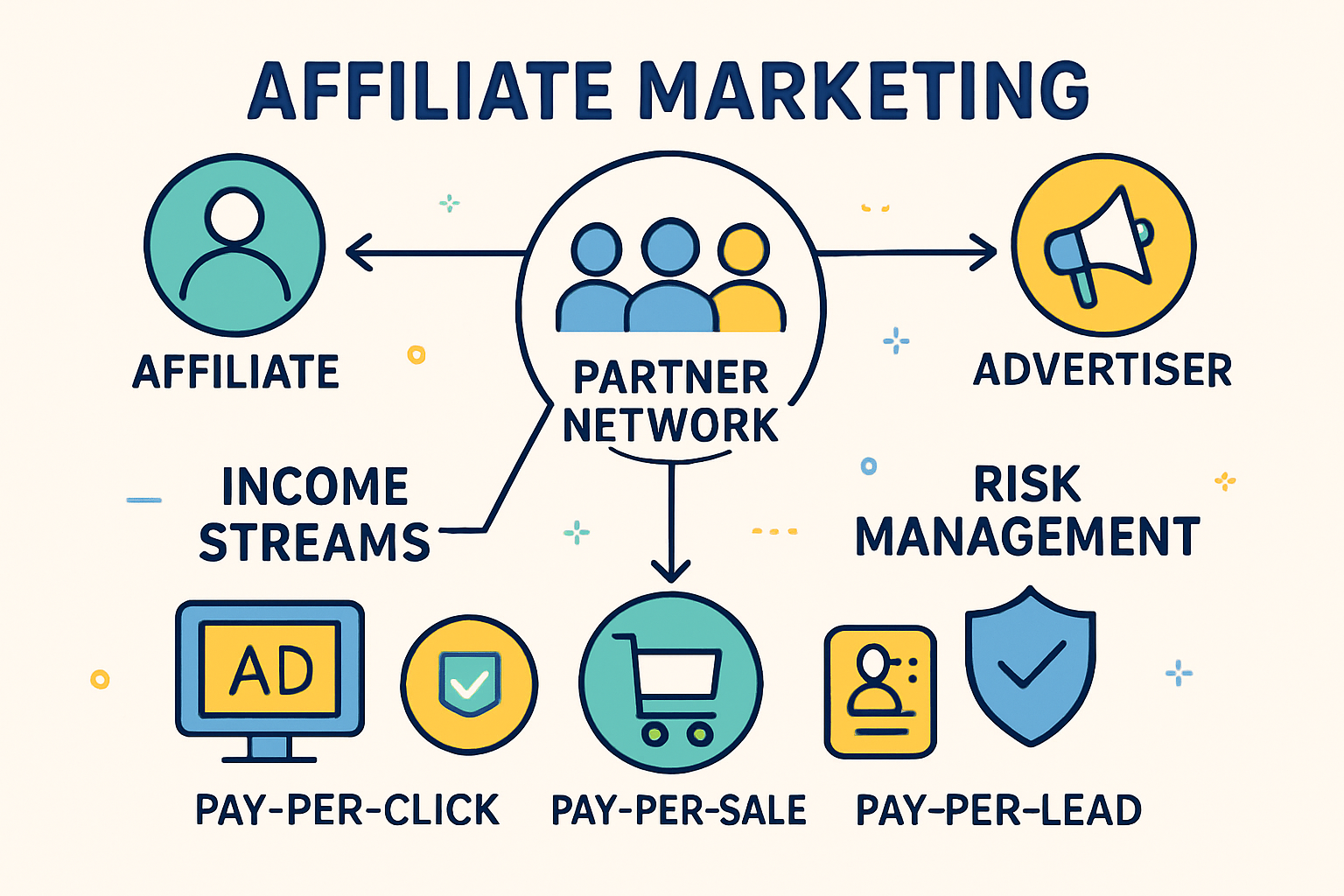In today’s ever-evolving economic landscape, businesses and individual marketers alike are recognizing the indispensable value of diversifying their affiliate income streams. The fluctuating market conditions of recent years, coupled with rapid technological advancements, have nudged many to reconsider their reliance on single or limited sources of revenue. By broadening affiliate partnerships and embracing a multi-faceted approach, affiliate marketers not only safeguard their income against uncertainties but also open doors to unprecedented growth opportunities. This strategy is no longer optional but essential for sustaining competitive advantage amid economic turbulence.
Affiliate marketing, with its attractive promise of passive income, has grown immensely popular. From technology firms to lifestyle influencers, diverse players are leveraging affiliate programs like Amazon Associates, ClickBank, and CJ Affiliate to monetize their platforms. However, depending solely on a few familiar networks or partners can expose marketers to risks like market shifts or platform algorithm changes. Expanding affiliate portfolios to include networks such as ShareASale, Rakuten Marketing, Impact, FlexOffers, Awin, eBay Partner Network, and the Shopify Affiliate Program provides a more resilient foundation and diversified revenue flow.
This article explores the multifaceted benefits of diversifying affiliate income streams, practical strategies for implementation, and examples of successful diversification in the context of 2025. It also delves into tools, common pitfalls to avoid, and the growing role of innovative platforms in supporting marketers’ efforts to scale sustainably. From risk mitigation to leveraging new technologies, understanding these elements equips affiliates with the insights to thrive amid economic challenges and build a flourishing digital business.
How Diversifying Your Affiliate Program Mitigates Risks and Enhances Stability
Affiliate marketing is not immune to market fluctuations, consumer behavior shifts, and technological disruptions. Consequently, marketers focusing on a narrow set of affiliate programs face heightened vulnerability during economic downturns or abrupt industry changes. By diversifying your affiliate program, you effectively distribute the risk and enhance overall income stability.
A program anchored solely on a few traditional partners like Amazon Associates or CJ Affiliate, while lucrative, may suffer if there are changes in commission structures or tightened program policies. Conversely, incorporating a range of partner types — including technology partners, social media influencers, and niche-specific platforms — distributes this risk.
Consider the experience of a fictional company, GreenTech Solutions. Initially, they relied heavily on the Shopify Affiliate Program alone. During a sudden policy modification limiting commissions, their revenue plateaued. However, upon expanding their partnerships to include networks such as FlexOffers and Rakuten Marketing, and adding collaborations with tech influencers, GreenTech diversified its income base. This ensured cash flow continuity despite marketplace volatility.
Key Advantages of Risk Mitigation through Diversification
- Reduced Vulnerability: Spreading income sources minimizes the impact from any one program’s policy change.
- Cash Flow Stability: Multiple steady income streams smooth out fluctuations in individual partner performance.
- Business Continuity: Diverse affiliates create a buffer against economic recessions and unexpected market shocks.
Technological innovation also supports risk mitigation. Investing in data analytics tools and advanced attribution technologies allows marketers to monitor performance accurately and adapt swiftly. Platforms like Acceleration Partners have demonstrated how leveraging these tools leads to measurable growth, including a 41% drop in cost per sale and significant revenue boosts for clients.
| Affiliate Network | Risk Level | Commission Flexibility | Market Reach | Example Use Case |
|---|---|---|---|---|
| Amazon Associates | Medium | Moderate | Global | General product promotions with broad appeal |
| ClickBank | Low to Medium | High | Global | Digital products and niche markets |
| Rakuten Marketing | Low | Moderate | Regional and global | Retail and lifestyle brands |
| Awin | Low | High | Global | Multi-industry partnerships |
Diversification also involves combining active and passive affiliate income sources, striking an efficient balance that maximizes long-term gains while securing short-term liquidity. Agencies specializing in affiliate marketing often advise adopting such bi-level approaches to address unstable economic conditions effectively. Explore comprehensive insights on maximizing affiliate revenue to develop a robust program resilient to unpredictable shifts.

Scaling Affiliate Income: Exploring Growth Opportunities through Diverse Partnerships
While risk mitigation remains a fundamental benefit, diversifying affiliate income streams can unlock significant growth potential. An economic slowdown doesn’t necessarily equate to stagnation; it can create a fertile environment for innovators to capture market share when competitors cut back on their spending.
For instance, Acceleration Partners’ client Le Col strategically expanded its affiliate marketing partnerships in 2024, targeting emerging influencers and niche technology affiliates beyond traditional channels. This strategic pivot translated to an impressive 85% quarter-over-quarter revenue increase, showcasing how diversification fuels brand growth and profitability.
Strategies for Leveraging Growth through Diverse Affiliate Programs
- Tap Into New Markets: Collaborate with affiliates who target untapped demographics or geographies.
- Experiment with Niche Affiliates: Promote specialized products through networks like ClickBank to access dedicated audiences.
- Utilize Social Media Influencers: Engage micro-influencers who drive authentic sales conversion.
- Adopt Emerging Technologies: Incorporate AI-powered marketing tools to optimize campaigns and personalize offers.
By adopting a multi-pronged approach involving networks such as ShareASale and Impact, alongside influencer partnerships, affiliates diversify not just revenue streams but also marketing strategies. This layered approach enhances competitiveness and aids brand recognition.
The following table summarizes popular affiliate networks suited for different growth strategies:
| Affiliate Network | Recommended For | Unique Feature | Average Commission |
|---|---|---|---|
| ShareASale | Niche market penetration | Large variety of small to medium merchants | 10-20% |
| Impact | Enterprise-level brands | Advanced partnership management tools | 15-25% |
| Rakuten Marketing | Retail and lifestyle brands | Strong global brand partnerships | Up to 20% |
| FlexOffers | Wide range of categories | Comprehensive affiliate database | 5-15% |
Affiliate marketers can find detailed case studies and growth tactics in resources like Scale Affiliate Marketing, which offers expert advice on expanding into new domains while retaining focus on high-conversion channels.
Implementing Effective Diversification: Tools, Testing, and Expert Guidance
Transforming affiliate diversification from concept to reality hinges on utilizing advanced tools, rigorously testing campaigns, and collaborating with experienced agencies. These elements ensure the approach is data-driven, scalable, and adaptable to shifting market dynamics.
Investment in Advanced Technologies
Investments in marketing attribution software and data analytics are vital. They empower businesses to reward partners fairly and identify the highest performing affiliates, optimizing ROI. Technologies that accurately trace customer journeys across multiple touchpoints help avoid inefficient overspending.
A/B Testing and Optimization
Systematic A/B testing of affiliate offers, creative materials, and partner mixes helps pinpoint what resonates best with specific audiences. For example, testing different social media influencer campaigns can reveal the highest converting content styles or audiences, guiding budget allocation.
- Experiment with multiple affiliate networks to compare results.
- Test various commission models like CPA, CPL, or revenue share.
- Analyze conversion rates and optimize payment incentives.
- Adjust promotional content based on audience demographics.
Partnering with Experienced Agencies
Working with seasoned affiliate marketing agencies, like Acceleration Partners, offers access to cutting-edge strategies and expertise. These firms assist in crafting tailored diversification tactics, ensuring alignment with business goals and economic conditions. Such partnerships also provide continuous support to adapt campaigns dynamically.
When organizations collaborate with agencies, they can leverage holistic programs that cover from recruitment to activation and measurement, enhancing business continuity even during economic recessions. Learn more about expert partnership management techniques at Content Quality Affiliate Marketing.
| Tool or Approach | Purpose | Benefit |
|---|---|---|
| Attribution Software | Track affiliate contributions accurately | Fair compensation and informed decision-making |
| Analytics Platforms | Measure campaign effectiveness | Data-driven optimization for better ROI |
| A/B Testing | Test variables in campaigns | Identify high-performing strategies swiftly |
| Agency Partnerships | Access to expert guidance and support | Strategic diversification and risk mitigation |
Introducing new affiliate programs or technologies may initially require an adjustment period. Patience and ongoing re-evaluation are key to sustainable growth. Embedding diversification in long-term planning ensures the affiliate ecosystem remains robust.
Unlocking Passive Income: Content Creators and Affiliate Revenue Diversification
For content creators, income diversification goes beyond risk management. It fuels creative freedom and financial independence. In a digital space often dictated by fluctuating algorithms and shifting sponsorship landscapes, diversifying affiliate income is crucial to safeguard earnings and cultivate varied monetization methods.
Content creators can harness affiliate networks like Amazon Associates, ShareASale, and eBay Partner Network to build passive revenue streams that complement active income sources, such as freelance services or merchandise sales.
Popular Affiliate Income Streams for Creators
- Affiliate Marketing: Earning commissions by recommending products aligned with their brand and audience interests.
- Digital Products: Selling e-books, templates, or online courses crafted from expertise, generating ongoing passive income.
- Membership Subscriptions: Offering exclusive content or perks via Patreon or platforms like Fourthwall.
- Merchandise Sales: Branded physical products designed for fan engagement with minimal inventory handling.
Platforms like Fourthwall empower creators with seamless storefronts integrating merchandise, digital sales, and membership tiers, balanced with advanced analytics to assess performance. This approach not only diversifies income but also deepens audience connections, fostering loyalty and sustainable growth.
According to recent studies, income diversification also protects creators from platform de-monetization risks. For example, an influencer heavily reliant on sponsorships may face income drops when brands change budgets, but a diversified approach cushions such shocks.
| Income Stream | Level of Passive Income | Initial Effort | Potential Earnings |
|---|---|---|---|
| Affiliate Commissions | Medium | Moderate | Variable based on traffic and niche |
| Digital Products | High | High | Scaling with product catalog and audience |
| Membership Subscriptions | High | Medium | Recurring monthly income |
| Merchandise Sales | Low to Medium | Moderate | Dependent on fan base size |
For a detailed guide on ebook creation and market strategies to maximize these income streams, check out engaging ebook writing and ebook distribution practices.

Essential Steps and Tools to Build a Successful Diversified Affiliate Income Strategy
Implementing diversification effectively requires systematic planning, continually monitoring performance, and adapting strategies. Below are eight crucial steps content creators and affiliate marketers should follow to build sustainable diversified income portfolios.
- Assess Existing Income Sources: Identify current revenue streams and their stability.
- Research New Opportunities: Explore affiliate networks like Impact, Awin, and Shopify Affiliate Program to find complementary niches.
- Invest in Passive Stream Creation: Develop digital products or membership services that generate ongoing revenue.
- Start Small and Scale: Pilot new income channels carefully, learn, and expand gradually.
- Leverage Online Marketplaces and Platforms: Utilize tools such as Fourthwall for storefront management.
- Track and Analyze Performance: Use budgeting apps and analytics for optimization.
- Reinvest Profits Intelligently: Fund new projects or marketing efforts with earned revenue.
- Maintain Consistency and Adapt to Change: Keep learning and evolving with market trends.
| Step | Action | Tools or Platforms | Expected Benefit |
|---|---|---|---|
| 1 | Assess existing streams | Budgeting apps like Mint | Clear understanding of baseline income |
| 2 | Research new affiliates | Affiliate networks like ShareASale, CJ Affiliate | Diverse partnership opportunities |
| 3 | Create passive income | Fourthwall, Gumroad | Steady cash flow with minimal effort |
| 4 | Start small & scale | Test campaigns with A/B testing tools | Sustainable growth |
| 5 | Leverage marketplaces | Fourthwall storefronts | Efficient monetization of audience |
| 6 | Track & optimize | Analytics platforms like Google Analytics | Increased ROI & performance |
| 7 | Reinvest earnings | Financial management tools | Expanding income streams |
| 8 | Consistency & education | Online courses, newsletters | Long-term resilience & flexibility |
For more tactical advice on building profitable affiliate income, visit make money affiliate marketing and enhance your strategic toolkit.
Common Mistakes When Diversifying Affiliate Income
- Overextension: Avoid diluting efforts across too many channels without proper management.
- Neglecting Core Performers: Successful existing income streams still require upkeep and nurturing.
- Insufficient Research: Failing to analyze market fit or product demand can lead to wasted resources.
- Ignoring Passive Income Potential: Don’t overlook scalable sources that bring recurring revenue.
- Resistance to Adaptation: Stay flexible as market dynamics change and new trends emerge.
Avoiding these pitfalls ensures your diversification efforts are profitable, sustainable, and aligned with your overall brand strategy.
Frequently Asked Questions: Diversifying Affiliate Income Streams
- Why is diversification vital for affiliate marketers?
Diversification reduces dependency on a single income source, mitigates risks related to market or platform changes, and opens additional growth avenues. - Can I start diversifying with limited funds?
Yes, many diversification strategies like affiliate marketing expansion or digital product sales require minimal upfront investment and can grow gradually. - Which affiliate networks offer the broadest diversification options?
Networks such as Awin, ShareASale, and FlexOffers provide access to a wide variety of merchants across industries, ideal for diversification. - How does A/B testing enhance affiliate program diversification?
It allows experimentation with different partners, creatives, and strategies to identify what yields the best ROI, enabling informed scaling decisions. - What role do agencies play in successful diversification?
Agencies provide expertise, technology access, and strategic guidance to optimize affiliate partnerships and adapt to economic shifts efficiently.


